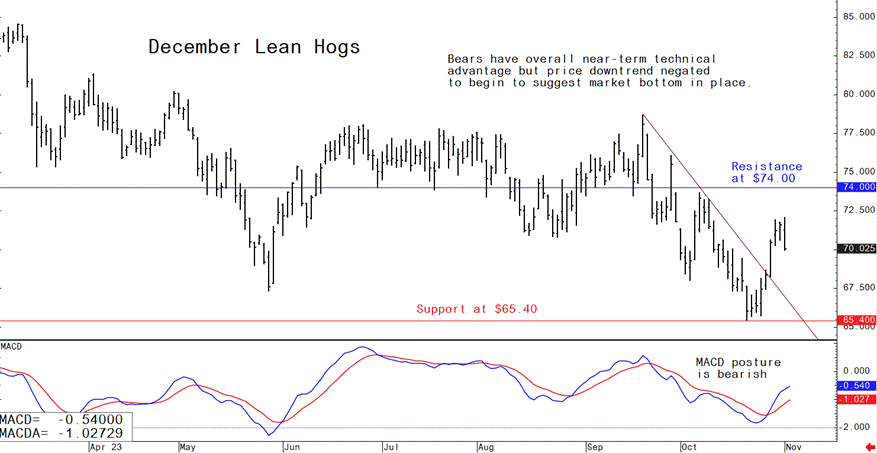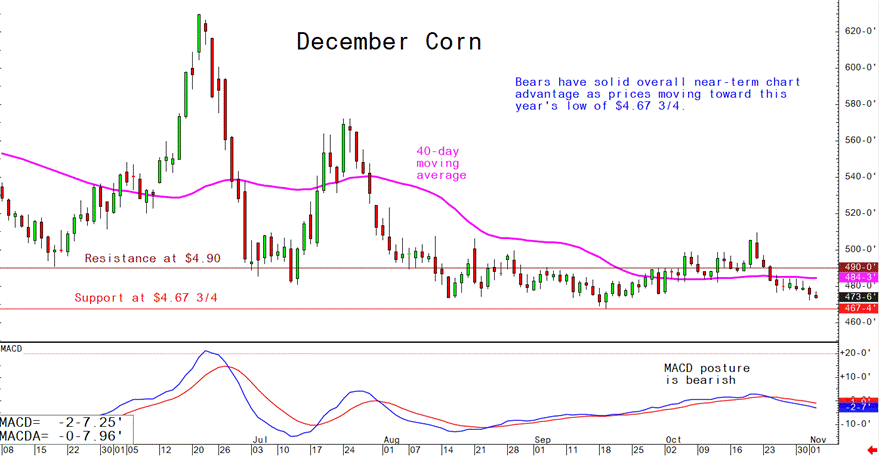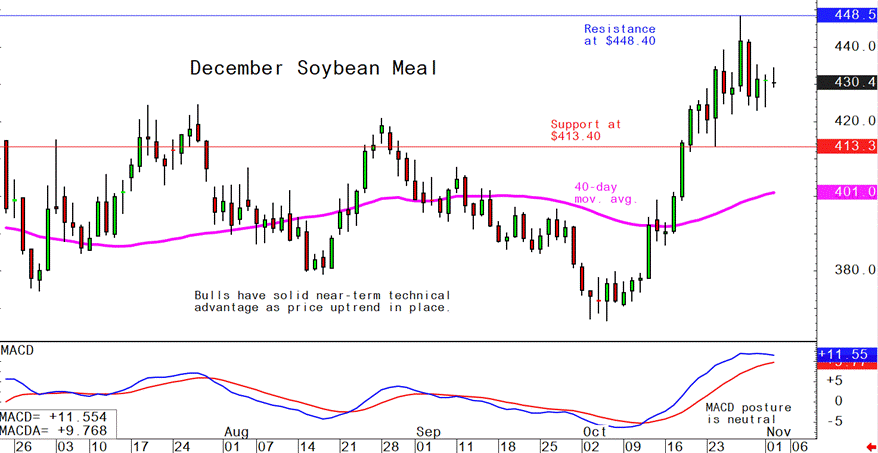



Pig outlook - Lean hog bulls working on a price rebound
Livestock analyst Jim Wyckoff shares pig news from around the globeDecember lean hog futures have made a decent rebound from the October low, to suggest a near-term market bottom is in place. However, the bulls have more work to do in the near term to suggest a price uptrend can be sustained on the daily bar chart. Traders Wednesday widened the discount December futures hold to the CME lean hog index, which is down another 19 cents to $76.94 as of Oct. 31. Hog market bulls need to step up and show more power soon to keep the price recovery alive.
Weekly USDA export sales for US pork
Pork: Net US sales of 31,100 MT for 2023 were up 10 percent from the previous week and 1 percent from the prior 4-week average. Increases primarily for Mexico (9,700 MT, including decreases of 200 MT), South Korea (7,300 MT, including decreases of 200 MT), Japan (2,900 MT, including decreases of 200 MT), Colombia (2,500 MT), and Australia (1,700 MT), were offset by reductions for Nicaragua (400 MT). Net sales of 500 MT for 2024 were primarily for South Korea. Exports of 28,800 MT were up 4 percent from the previous week and 5 percent from the prior 4-week average. The destinations were primarily to Mexico (10,400 MT), Japan (3,300 MT), South Korea (3,100 MT), China (2,500 MT), and Colombia (2,200 MT).
US pork producers seek partial ruling in ongoing Question 3 case
Pork producers have requested a Massachusetts federal court to proceed with a partial summary judgment in their challenge to Massachusetts' Question 3 (Q3) and its constitutionality. Question 3, which was voted on in 2016 and became effective on Aug. 23, 2023, prohibits the sale of uncooked whole pork meat that does not meet the state's sow housing requirements.
In July, Triumph Foods filed a lawsuit contesting the law, arguing that discriminatory trade restrictions like Q3 and similar laws affect the ability to establish resilient and reliable food supply chains across the United States. The lawsuit also claimed that such laws harm small businesses, employees, consumers, and government-funded agencies, emphasizing the importance of free and fair interstate commerce.
In May, the U.S. Supreme Court ruled against the National Pork Producers Council (NPPC) and the American Farm Bureau Federation in their challenge of California's Proposition 12 animal confinement law, which shares similarities with Massachusetts' Question 3.
In August, a settlement was reached that allowed pork to move through Massachusetts if it was sold outside the state. Then, in October, a group of 13 attorneys general from various states filed an amicus brief arguing against Question 3. They contended that the law could lead to inconsistent regulations by different states, disrupting national markets and causing significant financial harm to pork producers nationwide.
Of note: California has delayed compliance with Proposition 12 until Dec. 31.
US producers embrace USDA's Livestock Risk Protection Program as adoption surges to 5.2 million head
Producers in the US, particularly in the southern states, are increasingly embracing the Livestock Risk Protection Program (LRP), a program aimed at safeguarding ranchers against declining cattle prices, according to an item released by Southern Ag Today. LRP adoption has seen significant growth, with the number of cattle head covered surging from 71,000 in 2017 to 5.2 million by October 2023. In 2022, ranchers insured 3.4 million head, compared to 1.8 million in 2021. Notably, the Southern region has played a substantial role in driving this increased usage, with Texas and Oklahoma insuring 56% and 34% of the total, respectively.
China’s hog numbers down from year-ago
China’s sow herd at the end of September totaled 42.4 million head, down 2.8% from last year, the ag ministry said. The pig herd dropped 0.4% to 44.23 million head.
Cold Storage report: US pork stocks remain well below average
USDA’s latesr Cold Storage Report showed frozen beef stocks climbed more than average during September, largely because the previous month’s figure was revised down 15.1 million pounds. Pork stocks declined last month, whereas there is normally a small buildup in supplies.
Frozen pork inventories totaled 462.8 million lbs., down 6.5 million lbs. (1.4%) from August, whereas the average over the past five years was a 3.0-million-lb. increase during September. Pork stocks fell 74.3 million lbs. (13.8%) from last year and were 69.4 million lbs. (13.0%) lower than the five-year average. Frozen ham inventories at 149.5 million lbs. dropped 4.8 million lbs. and were 10.0 million lbs. under September 2022. Belly stocks at 29.6 million lbs. declined 7.2 million lbs. during September and were 6.9 million lbs. under year-ago.
USDA strengthens animal welfare standards for organic livestock, aims to elevate organic farming practices
USDA is set to implement enhanced animal welfare regulations for organic livestock, offering more consistent and stringent standards for the treatment of animals on organic farms. USDA Secretary Tom Vilsack announced the forthcoming regulation, which is expected to come into effect by the end of the year.
The new rule mandates unlimited outdoor access for animals, aligning with industry norms, and prohibits the use of small enclosed "porches" that some poultry farms have utilized. Additionally, the regulation requires producers to provide sufficient space for cattle, hogs, and poultry to engage in natural behaviors, including standing up, turning around, lying down, fully stretching their limbs, and conducting activities such as rooting for pigs. These requirements set organic farming apart from conventional agriculture, where practices like housing egg-laying hens in "battery" cages and restraining pregnant sows in sow crates are common.
Vilsack highlighted USDA's goal of creating a fairer, more competitive, and transparent food system through this regulation, emphasizing the importance of consistent animal welfare practices in organic production.
The Organic Trade Association (OTA) welcomed the animal welfare rule, stating that it would level the playing field for organic producers and provide consumers with confidence that organic meat, poultry, dairy, and eggs have been produced in humane conditions with ample outdoor access. In 2022, sales of organic food exceeded $60 billion, according to the OTA.
The next week’s likely high-low price trading ranges:
December lean hog futures--$65.40 to $74.00 and with a sideways-higher bias
December soybean meal futures--$415.00 to $450.00, and with a sideways-higher bias
December corn futures--$4.60 to $4.90 and a sideways-lower bias
Latest analytical daily charts lean hog, soybean meal and corn futures












